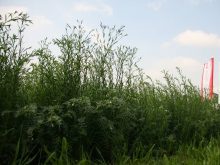Glacier FarmMedia – New clubroot pathotypes are emerging in canola fields across the Prairies and clubroot-resistant varieties might not be enough to stop the spread.
“The most worrisome part about this is the fact that a lot of these new pathotypes are able to overcome traditional first-generation resistance,” said Keisha Hollman, who led the study at the University of Alberta as part of her master’s degree.
“We actually have 36 unique pathotypes now, and 19 of the 36 are able to overcome traditional first-generation resistance.”
Read Also

Claas brings 1000 Series SP forage harvesters to Canada
In mid-August, Claas unveiled its new line of Jaguar forage harvesters at an event in Visalia, California, deep in the heart of that state’s dairy region.
A new pathotype is a variant and arises all the time in viruses, bacterium, or other disease-causing micro-organisms. The three dozen new clubroot pathogens were found as a result of a clubroot survey conducted across the Prairies in 2017-18 by a U of A research team led by Hollman. The survey found fields seeded to clubroot-resistant canola varieties that had “particularly bad symptoms,” showing that genetic resistance continues to break down in Alberta. They also found the first example of the resistance failing in Manitoba as well.
“It’s what we call pathotype shifting, which we’ve seen occurring quite a bit more frequently,” said Hollman. “Within a field, you typically don’t have just one pathotype — it will actually be a mixture of pathotypes. By growing genetically resistant varieties and relying solely on genetic resistance, we’re depleting the inoculum of the most dominant pathotypes in the soil.
“Then over time, you’re giving the other pathotypes that are present in smaller quantities in the field the chance to grow and expand their populations.”
And for the most part, these new pathotypes don’t have genetic control options, she added. While new cultivars with second-generation resistance are starting to hit the market, development of this resistance is in its infancy.
And breeders can’t go after every possible threat.
“Breeding is going to focus on the most dominant of these new pathotypes — that’s pathotype 3A and 3D,” she said. “If you have the more unique ones, it’s probably going to take breeding a long time to catch up. So if we can prevent them from spreading further, that would be very beneficial.”

Right now, the Edmonton area is the biggest hot spot for new pathotypes, but researchers also found some unique pathotypes isolated in single fields or adjacent fields in northern Alberta, and as noted earlier, as far away as Manitoba.
“That’s where mapping can be a great tool,” said Hollman. “If we know that we have these pathotypes only in a very isolated spot, hopefully we can prevent that pathotype from spreading further.”
That will be critical as these new pathotypes start to impact canola production in the region.
“Clubroot can be very severe if not managed properly and can lead to yield losses of 90 or 100 per cent,” she said. “Genetic resistance is a very effective tool, and if it’s no longer available, it’s going to be a lot harder to control clubroot, particularly in heavily infested situations. It will take more of an integrated strategy.”
Rotation, cleaning, and simple things
Historically, producers in the most affected areas have relied heavily on genetic resistance to manage clubroot, but in fields where new pathotypes are overcoming resistance, those cultivars will no longer be an option for clubroot management.
And with the length of time it takes to breed new varieties — typically between 10 and 12 years — these new pathotypes could gain a foothold in fields before the genetics catch up, said Hollman.
“Even if you’re planting a clubroot-resistant variety, you’re still going to see clubroot symptoms if you have one of these resistance-breaking pathotypes,” she said. “So we also need to incorporate other management strategies in order to protect the longevity of our resistant sources, especially in situations where genetic resistance may no longer be an option.”
The first step is shifting to a four-year crop rotation with non-host crops such as pulses or cereals — not always a favourite option among farmers, but a necessary one, she said.
“Rotation is a very effective tool, particularly if you do have very high disease severity in your field or even as a preventive measure,” said Hollman.
“Typically about a one-in-four rotation will deplete inoculum in the soil to levels that are low enough that you won’t really see any disease symptomology by the fourth year, when you’re back to growing canola again.”
Sanitizing equipment is another important step that, again, isn’t terribly popular among farmers.
“I know that cleaning equipment between fields is impossible because it’s so time consuming, but even just knocking off big chunks of dirt from equipment will help,” said Hollman.
“Clubroot is spread by soil and there’s billions of resting spores in the soil. So the more soil you can get off your equipment, the less likely you are to transfer those spores from one field to the next.”
Working your most infected field last is another easy strategy to reduce the spread.
“If you know you have a very severe field, make sure you’re working that one last so you’re not dragging that soil from that field to all of your other fields.”
Patch management through things like liming can also help, but they’re most effective on small, heavily infested patches or at field entrances.
“That’s a great option as well — grassing field entrances. If you know that you do have clubroot, it will help take dirt off tires as you’re exiting your field.”
While these strategies may not be as simple as using genetic resistance to combat clubroot, a more integrated approach will become increasingly necessary as these new pathotypes arise and spread.
“Genetic resistance is such a wonderful tool because you just buy your seed and it already has the resistance bred in, so it makes management easy. But we’re finding so many new pathotypes every year,” she said.
“We need these other tools to protect the longevity of resistance sources, particularly for these new second-generation resistant varieties. Otherwise, it’s going to have a significant impact on canola production.”
Jennifer Blair is a reporter with the Alberta Farmer Express. Her article originally appeared in the May 3, 2021 issue.















